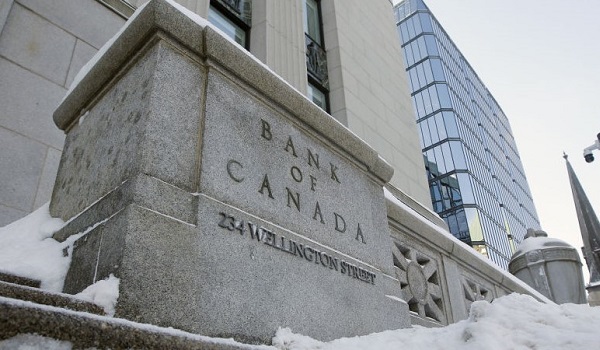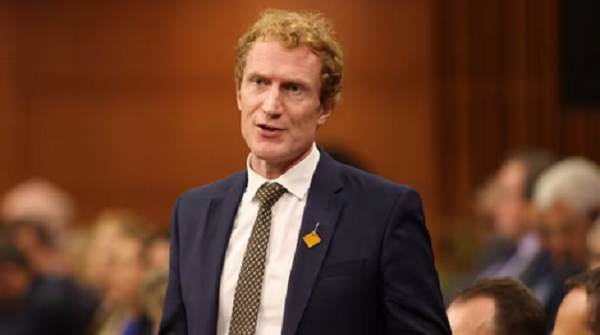Money markets raise odds for BoC rate cut in July after inflation data
Money markets have increased their bets that the Bank of Canada will cut interest rates again on July 24 in the wake of this morning’s modestly tamer-than-expected June inflation data.
Implied probabilities of future interest rate moves in swaps markets now suggest a 92 per cent chance of a Bank of Canada quarter-point rate cut at that meeting, up from 83 per cent odds just prior to the 8:30 am ET report, according to data from LSEG. Nearly three more quarter-point cuts are now priced into markets by the end of this year, which would bring the bank’s overnight rate to 4 per cent.
Currency markets also interpreted the data as dovish, with the Canadian dollar dropping about two-10ths of a cent following the data, to 73.00 cents US. Bond market reaction was fairly subtle, with Canada’s two-year bond yield holding close to 3.8 per cent, nearly unchanged for the session. That partly reflected a stronger-than-expected U.S. retail sales report that was released at the same time, which put upward pressure on North American bond yields.
Coming into this month, probabilities for an interest rate cut on July 24 were essentially down to a coin flip. But several economic reports since then – most notably a weak June Canadian jobs report – had markets increasingly pricing in a July 24 quarter-point rate cut by the BoC. Several economic reports and dovish Federal Reserve market commentary out of the U.S. in recent days also now have markets nearly fully pricing in a Fed rate cut in September – which has raised confidence levels further that the BoC will soon cut rates a second time.
Canada’s annual inflation rate cooled a tick more than expected to 2.7 per cent in June, largely due to softer growth in gas prices, while core inflation measures were marginally down. Analysts polled by Reuters had forecast the inflation rate would tick down to 2.8 per cent from 2.9 per cent in May.
Month-over-month, the consumer price index was down 0.1 per cent, compared with a forecast for no change. This was the first deceleration in the monthly inflation rate since December, Statistics Canada data showed.
Here’s how implied probabilities of future interest rate moves stand in swaps markets, according to data from LSEG as of 1007 am ET. The Bank of Canada overnight rate is 4.75 per cent. While the bank moves in quarter point increments, credit market implied rates fluctuate more fluidly and are constantly changing. Columns to the right are percentage probabilities of future rate moves.
Here’s how economists and market strategists are reacting in written commentaries this morning:
Royce Mendes, managing director and head of macro strategy, Desjardins Securities
After the prior month’s detour, inflation was back on a track towards the Bank of Canada’s 2% target in June. … The inflation reading for Q2 of 2.7% is notably below the Bank of Canada’s forecast of 2.9% for period.
Core measures of inflation looked significantly tamer in June relative to May. Excluding food and energy, prices were up a more trend-like 0.2% in seasonally-adjusted terms, leaving the twelve-month pace of that measure at 2.9%, within the central bank’s control range. The Bank of Canada’s core measures of inflation also showed signs of progress, with median and trim both increasing 0.2% during the month. That saw the year-over-year rates of both metrics slow. While the three-month annualized rates did accelerate, they tend to be volatile and won’t be enough to scare central bankers off cutting rates on July 24th.
A return to tepid consumer price growth likely seals the deal for a follow up 25bp rate cut from the Bank of Canada next week. Along with significant declines in inflation expectations and a further normalization in corporate pricing behaviour, the latest inflation data build a strong case for continuing the rate cutting cycle without delay. That’s particularly true in light of the subdued survey responses from consumers and businesses about the outlook for the Canadian economy.
Stephen Brown, deputy chief North America economist, Capital Economics
The Bank of Canada’s preferred CPI-trim and CPI-median measures of core prices rose at an above-target monthly pace for the second month running in June. Nonetheless, with the Bank’s Business Outlook Survey, released yesterday, pointing to much more disinflationary pressure in the pipeline, we still think the odds favour another interest rate cut next week.
CPI-trim and CPI-median each rose by 0.24% m/m, above the rate of 0.17% that would be consistent with 2% inflation, but smaller than the average gain of 0.33% in May. The Bank can also take some encouragement from trends in the other key price indices, with CPIX – which excludes eight of the most volatile components – rising by just 0.1% and headline prices also rising by just 0.1%. …
As the closely watched three-month annualised change in CPI-trim and CPI-median picked up further to 2.9% in June, we can’t completely rule out a pause from the Bank next week. Our sense, however, is that the Bank is likely to be growing more concerned about the downside risks of its still tight policy stance. The unemployment rate jumped to 6.4% in June and the Business Outlook Survey suggests that wage pressures have eased considerably, all of which should give the Bank confidence that core inflation will continue to fall.
James Orlando, director and senior economist, TD Economics
Today’s CPI report was a bit of a mixed bag. While headline inflation got back on track in June, the three-month annualized pace of core inflation has now been rising for three straight months. This infers that the annual pace of inflation should remain in the upper end of the BoC’s 1% to 3% range over the coming months. This has been propelled, not just by shelter prices, but also by price gains in “nice-to-haves” like the cost of dining out, health spending, and household operations.
The BoC is set to make a rate announcement next week and today’s report has increased odds of back-to-back rate cuts. Recent data have supported a cut, with the job market loosening and wage gains decelerating from elevated levels. From our view, the story hasn’t changed. The BoC is in a cutting cycle. Whether or not it follows through with a slightly quicker pace of cuts next week, Canadians should expect rates to be steadily reduced over the rest of this year and next.
Katherine Judge, senior economist, CIBC
The inflation data for June gave the Bank of Canada what it needed in order to cut interest rates at next week’s meeting. The headline CPI decelerated by two ticks to 2.7% y/y, in line with the consensus expectation. But more important for policymakers, their preferred measures of core inflation, CPI-trim and CPI-median both showed a monthly advance of 0.2% (seasonally adjusted), down from a 0.3% pace in the prior month. Other key core measures also improved, with CPIX decelerating to a 0.1% m/m pace, and CPI ex. mortgage interest costs at 1.9% y/y. This shows that the prior month’s upside surprise in inflation was just a blip in a broader trend of disinflation as demand in the economy remains under pressure, paving the way for a BoC cut next week.
Benjamin Reitzes, managing director, Canadian rates and macro strategist
The details of the report are consistent with the backdrop of consumers becoming increasingly cautious with discretionary spending. There was notable softness in recreation and clothing. A steep 11.1% drop in travel tours, continuing the extreme volatility in the category, weighed on recreation. Clothing was weaker across the board. Shelter also came in on the soft side, with rent seeing the smallest increase (+0.1%) in nearly two years, and a drop in utilities providing a helping hand.
However, there were some challenging aspects, as food prices perked up for a second consecutive month (+0.6% seasonally adjusted), which followed four months of flat-to-lower prices. Insurance costs are also accelerating, with auto insurance up 8.1% y/y (four-year high) and home insurance up 9.2% (though down a tick from the prior month).
Key Takeaway: The June CPI came in on the soft side continuing the slow but steady march toward the 2% inflation target. Today’s CPI report, taken with the weak Q2 Business Outlook Survey, the ongoing march higher in the jobless rate, and increased economic slack are expected to provide policymakers with enough confidence that inflation will continue slow to ease policy rates 25 bps to 4.5% on July 24.
Claire Fan, economist, Royal Bank of Canada
June’s CPI print was a small relief after an upside surprise in May. …The Bank of Canada’s preferred CPI trim and CPI median both dropped lower on a monthly basis although the narrower “supercore” measure held slightly higher. Yesterday’s second quarter release of the BoC’s Business Outlook Survey largely confirmed further normalizing in a few key areas that the central bank has deemed critical to future inflation trends, including firms’ pricing behaviour, their expectations for inflation in the future as well as wage growth. All told, we expect the BoC will carry on with easing the monetary brakes on a weak economy, and follow up with another rate cut at its July meeting next week.
Tu Nguyen, economist with assurance, tax & consultancy firm RSM Canada
June’s inflation report confirms that the Canadian economy is firmly on a disinflationary trajectory as headline inflation drops to 2.7% due to slower growth in gasoline prices and core inflation measures see little change.
Shelter inflation – the most stubborn category – is showing signs of slowing thanks to the increased supply of new condos in the market. There was no surprise in the data as all categories saw inflation stay steady.
We believe that the Bank of Canada should cut the policy rate by 25 basis points next week, bring the policy rate to 4.5%.
Inflation is on track to reach 2.5% this year and return to 2% next year. Keeping the policy rate unnecessarily restrictive risks a policy error and raises recession odds. In addition, disinflation south of the border points to a Fed rate cut in September, which limits the divergence in the policy rates between the Bank and the Fed.
Philip Petursson, chief investment strategist, IG Wealth Management
We believe the focus for the Bank of Canada will have to shift from inflation – which we would argue they have already won the fight – to the economy. From the labour market perspective we are seeing a continued deterioration of conditions. Last month’s employment report was nothing short of disappointing. The unemployment rate continues to climb higher and currently stands 1.6% higher than it was at the low of July 2022. The economy is now losing full time jobs replacing them with part time. The quality of the labour market is weaker today. Canadians are coming under stress from multiple directions of interest rates (in the form of higher mortgage rates), the remnants of higher inflation, and a weaker labour market. The Bank can no longer take the attitude of only one ailment at a time. It now needs to weigh the risks of interest rates against not just inflation, but the Canadian economy as a whole. We believe the BoC will have to place more emphasis on the economy and as such, follow through with its next interest rate cut coming next week followed by two more cuts in the fall.”
This article was first reported by The Globe and Mail













